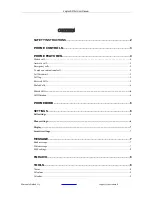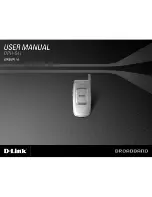
8
25
1.7 -
calls towards service center
1)
T
2)
3)
4)
After having taken the emergency call and received
5)
6)
7)
- when a new alarm cycle is triggered;
- by pressing the “*” key on the autodialler during the “Wait for call” status or during Stand-by;
- by pressing the “8” from a remote phone receiver (see § 1.8).
8) The autodialler exits from “Wait for call” status and gets back to Stand-by:
- after 3 minutes if “Incoming calls” is set on “OFF”;
- by pressing the “*” key on the autodialler;
- by pressing the “8” from a remote phone receiver (see § 1.8).
Notes:
- The alarm cycle is executed regardless from the availability of phone line. This is because different
line signals in some countries may prevent the alarm message to be sent.
- I
ETS8128CS.
Alarm cycle description for
The alarm cycle is common to all versions of the AMIGO telephone
In case of emergency, if a passenger in the lift car (or other person trapped in the lift installation)
pushes the alarm button of one of the alarm devices, the Emergency Telephone triggers the alarm
cycle and follows this sequence:
he Emergency Telephone connects to the phone line and dials the first stored number.
The "
alarm sent
" yellow LED switches on.
If the Emergency Telephone does not receive any answer for 60 seconds, it recalls the same
stored number. In case of no answer for the programmed number of times (see § 3.7), the line is
disconnected, the "
alarm sent
" LED stays on and the Emergency Telephone returns to the stand-
by mode, ready to start a new alarm cycle.
the
"ID number"
, the external operator of the
service center can establish the two-way conversation.
When conversation time expires (this parameter can be set by the customer, see § 3.10) the
Emergency Telephone sends 5 tones to the operator. If the operator presses the "
*
" key,
conversation time is extended; if the operator presses the "#" key the telephone disconnects the
telephone line, the yellow "
alarm sent
" LED switches off and the green "
alarm received”
LED
switches on. The message "
Wait for call
" will appear on the display.
When the Emergency Telephone is in "
Wait for call
" status (duration can be set by the client, see
§3.8), the external operator can connect to the site by dialing its phone number. When the
communication is established, the Telephone sends 5 tones; the same tones are passed to signal
that conversation time is about to end (conversation time can be extended by pressing the "
*
"
key). When the conversation is over, the Emergency Telephone returns to “Wait for call”.
The "
alarm received
" LED can be switched off:
- by pressing the
"alarm off"
button wired to the ALARM OFF input of the terminal board of the
autodialler (if the
"alarm off"
input is bridged the signal switches off automatically at the end of the
alarm cycle);
n the Quadriphony configuration (see §2.3), "alarm sent" and "alarm received" lights are placed in
the Car Slave Device
To record the “Site Identification” message, press “1”. A confirmation message (“Are you sure?”) will
pop up: press “1” to start recording (”0” to stop recording), speaking close to the microphone for 20
seconds max.
To record the “Low battery charge” message, press “3” and follow the same procedure.
To record the “Regular operation” message, press “5” and follow the same procedure.
To set “Messages”, press
WRITE
to access programming mode, then press “1” to set on “ON” or “0” to
set on “OFF”. Press
OK
to store the setting (If
OK
is not pressed within 30 seconds, the setting is
cancelled and the system goes back to Stand by).
Notes: all messages are sent through if the “Protocol type” option is set on ”No Protocol” (see § 3.13).
It is suggested to record a brief site identification message before both “Low battery charge” and
“Regular operation” messages to help the receiver in spotting the installation.
If no key is entered within 30 seconds, the autodialler will automatically get back to stand-by.
AMIGO
Emergency telephone
AMIGO
Emergency telephone


































